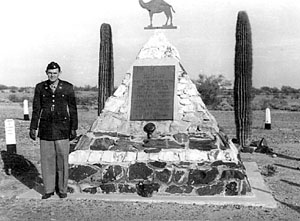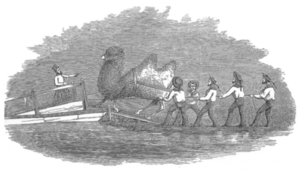United States Camel Corps facts for kids
Quick facts for kids United States Camel Corps |
|
|---|---|
| Active | 1856–1866 |
| Country | United States |
| Branch | U.S. Army |
| Type | Quartermaster |
| Role | Experimental |
| Post | Camp Verde, Texas |
| Commanders | |
| First commander | Major Henry C. Wayne |
The United States Camel Corps was a special project by the United States Army in the mid-1800s. The Army wanted to see if camels could be used as pack animals in the dry Southwestern United States. Even though camels were strong and good at traveling in the desert, the Army decided not to use them for military work. The American Civil War stopped the experiment, and the camels were later sold.
Contents
Why Camels?
The idea of using camels in the U.S. Army started in 1836. Major George H. Crosman thought camels would be very helpful for carrying supplies. He had seen how useful they could be during wars with Native American tribes in Florida.
Later, in 1848, Major Henry C. Wayne studied the idea more closely. He also believed that camels should be brought to the U.S. for military use. Senator Jefferson Davis of Mississippi agreed with Wayne. Davis became the United States Secretary of War in 1853. He saw that the Army needed better ways to move things in the dry Southwest.
In 1854, Davis suggested using camels again. On March 3, 1855, the U.S. Congress approved $30,000 for the project. This money was used to buy camels.
A former Navy officer, Edward Fitzgerald Beale, also thought camels were a good idea. He said he got the idea while exploring Death Valley. He convinced his friend, Lieutenant David Dixon Porter, to lead the trip to get the camels.
Getting the Camels
Major Wayne was put in charge of buying the camels. On June 4, 1855, Wayne and Lieutenant David Dixon Porter sailed on the USS Supply. They traveled to places like Tunisia, Malta, Greece, Turkey, and Egypt to find camels.
They bought 33 camels on their first trip. These included different types, like Bactrian camels and dromedaries. They also bought special saddles for the camels. Wayne and Porter hired five camel drivers from Arab and Turkish regions.
On February 15, 1856, the USS Supply sailed back to Texas. Porter made sure the camels were well cared for during the long journey. One camel died, but two baby camels were born. So, 34 camels arrived safely in Indianola, Texas, on May 14, 1856. They were all healthier than when they started the trip.
Porter then went on a second trip to Egypt to get more camels. While he was gone, Wayne marched the first group of camels to Camp Verde, Texas. This camp became the main camel station.
On February 10, 1857, Porter returned with 41 more camels. He also hired more drivers, including a famous one named Hi Jolly. With the new camels, the Army had 70 camels in total.
Camels at Work in the Southwest
The Army wanted to test the camels to see how well they could help with military tasks. In 1857, James Buchanan became President, and John B. Floyd took over as Secretary of War. Major Wayne was replaced by Captain Innis N. Palmer at Camp Verde.
Exploring the West with Camels
In 1857, Congress asked for a new road to be surveyed from the East to the West. Edward Fitzgerald Beale won the contract for this job. Secretary Floyd told him to take 25 camels with him.
The expedition started from San Antonio on June 25, 1857. The camels carried heavy loads of 600 pounds each. Beale was very impressed with the camels. He wrote that they were strong and could carry a lot. He even said he would rather have one camel than four mules.
Beale's positive reports made Secretary Floyd suggest buying 1,000 more camels. However, Congress did not approve this. Beale and his group reached the Colorado River on October 26, 1857. After the expedition, Beale used the camels on his ranch in California.
More Tests in Texas
On March 25, 1859, Secretary Floyd ordered more tests for the camels in Texas. Lieutenant William E. Echols and Lieutenant Edward L. Hartz led an expedition with 24 camels and 24 mules. They wanted to see how well the camels could survive without water.
The camels traveled 85 miles without wanting water. Hartz wrote that camels were much better than mules for military use in dry areas. Another trip in July 1859 showed that camels could travel over very rough land for many days.
Robert E. Lee, who was a U.S. Army officer at the time, also saw the camels. In 1860, he ordered Echols to do another survey. This time, 20 camels and 25 mules were used. The camels again performed better than the mules, especially in very dry areas. Three mules died on this trip, but all the camels survived. Lee wrote that the camels were very reliable and helped the mission succeed. This was the last long trip for the camels before the Civil War began.
Interestingly, the camels ate a plant called creosote bush, which most other animals avoid. It's thought this was because their ancestors, like the Camelops, used to eat similar plants in America long ago.
What Happened Next?

At the start of the Civil War, there was an attempt to use camels to carry mail. But this did not work out. Later, the Army lost interest in the camels. They were sold at an auction in 1864. The last camel from California was reportedly seen in Arizona in 1891.
In 1861, Camp Verde was taken over by the Confederate army. They took 80 camels. There were stories of the camels being used to carry supplies for the Confederates, but there is no strong proof. When the Union army took back Camp Verde in 1865, there were over 100 camels there.
In 1866, the government gathered 66 camels and sold them. This marked the end of the U.S. Army's camel experiment. The last camel seen near Camp Verde was in 1875.
The camel experiment failed for a few reasons. One big reason was that Jefferson Davis, who supported the idea, left the U.S. Army to become the President of the Confederate States. Also, U.S. soldiers were used to horses and mules. They did not know how to work with camels very well.
One camel at Fort Tejon was killed by another male camel during mating season. Its bones were sent to the Smithsonian Institution for display.
Some people believe that a camel that escaped, or its descendant, led to the Arizona legend of the Red Ghost.
One of the camel drivers, Hi Jolly, lived in the United States until he died in 1902. He is buried in Quartzsite, Arizona. His grave has a pyramid-shaped monument with a metal camel on top.
Camels in Movies and TV
- The 1954 movie Southwest Passage (also called Camel Corps) is about this topic.
- The TV show Death Valley Days had an episode in 1957 called "Camel Train" about the camels.
- In 1957, an episode of "Have Gun Will Travel" called "The Great Mojave Chase" showed the hero riding a camel from the Camel Corps in a desert race.
- The TV series Maverick had an episode in 1957 called "Relic of Fort Tejon." In it, the main character wins a camel.
- In 1976, a comedy movie called Hawmps! was loosely based on the U.S. Camel Corps.
Images for kids
-
Camel at Drum Barracks, San Pedro, California (1863 or earlier)
See also
 In Spanish: Cuerpo de camellos de Estados Unidos para niños
In Spanish: Cuerpo de camellos de Estados Unidos para niños



